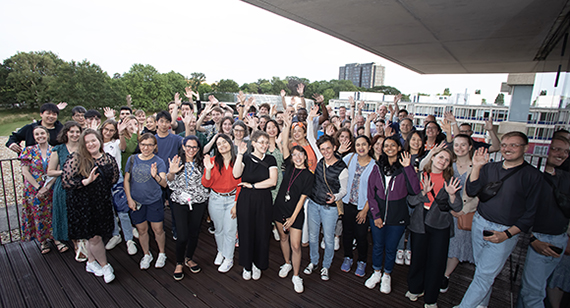Accessibility statement
This accessibility statement applies to this website, https://essexsummerschool.com/
This website is run by the University of Essex. We want as many people as possible to be able to use our website and we’re committed to providing an accessible web presence, by making the information and resources we provide accessible to all web users. For example, that means you should be able to:
- change colours, contrast levels and fonts
- zoom in up to 300% without the text spilling off the screen
- navigate most of the website using just a keyboard
- navigate most of the website using speech recognition software
- listen to most of the website using a screen reader (including the most recent versions of JAWS, NVDA and VoiceOver)
We’ve also made the website text as simple as possible to understand.
AbilityNet has advice on making your device easier to use if you have a disability.
How accessible this website is
We know some parts of this website are not fully accessible:
- some of our images are missing alternative text
- you cannot modify the line height or spacing of text
- most older PDF documents are not fully accessible to screen reader software
- live video streams do not have captions
- some of our online forms are difficult to navigate using just a keyboard
- you cannot skip to the main content when using a screen reader
- there’s a limit to how far you can magnify the map on our ‘contact us’ page
Feedback and contact information
If you need information on this website in a different format like accessible PDF, large print, easy read, audio recording or braille:
email esumsda@essex.ac.uk
call +44 (0)1206 876270
Address: University of Essex
Wivenhoe Park
Colchester
CO4 3SQ
United Kingdom
We’ll consider your request and get back to you in 10 days.
Reporting accessibility problems with this website
We’re always looking to improve the accessibility of this website. If you find any problems not listed on this page or think we’re not meeting accessibility requirements, contact the Essex Summer School Team on esumsda@essex.ac.uk
Enforcement procedure
The Equality and Human Rights Commission (EHRC) is responsible for enforcing the Public Sector Bodies (Websites and Mobile Applications) (No. 2) Accessibility Regulations 2018 (the ‘accessibility regulations’). If you’re not happy with how we respond to your complaint, contact the Equality Advisory and Support Service (EASS).
Contacting us by phone or visiting us in person
Information on how to contact the University can be found on our contact us webpages. Alternatively, information on visiting us in person can be found on each of our three University of Essex campus pages:
Technical information about this website’s accessibility
The University of Essex is committed to making its website accessible, in accordance with the Public Sector Bodies (Websites and Mobile Applications) (No. 2) Accessibility Regulations 2018.
Compliance status
This website is partially compliant with the Web Content Accessibility Guidelines version 2.1 AA standard, due to the non-compliances listed below.
The content listed below is non-accessible for the following reasons:
- On the majority of our webpages, text scaling and zooming is disabled on touch screen devices. This prevents users scaling text or zooming into the page without the use of assistive technologies such as a screen magnifier. This fails WCAG 2.1 success criterion 1.4.4 (Resize text). We plan to address this issue to enable text scaling and zooming on touch screen devices by 24/05/2024.
- Where we have used ARIA input fields, most of these are missing accessible names, preventing users with assisted technology being able to read them. This fails WCAG 2.1 success criterion 2.4.22. We plan to address this, by adding labels and names to all our ARIA input fields by 24/05/2024.
- Our <html> pages have not set a defined language, which prevents users of assisted technology from knowing what the default language of the web page is. This fails WCAG 2.1. success criterion 3.5.7. We plan to fix this by 24/05/2024.
- Some of our link text is the same but used for multiple different destinations on the same page. This makes it difficult for some people to know where the link points to without further explanation. This fails WCAG 2.1 success criterion 2.4.4 (Link purpose (in context)). We plan to ensure all of our link text is unique for each new destination by 24/05/2024. We’ll make sure any new links added are unique.
- On some pages we are used interactive elements which have been nested. Assisted technologies do not announce nested interactive elements so this means it is not possible for these users to access this content. This fails WCAG 2.1 success criterion 4.2.50. We plan to fix this by 24/05/2024.
- On some pages, in certain areas the colour contrast is insufficient. This can present a problem for users with low-vision or colour-blindness. This fails WCAG 2.1 success criterion 1.4.3 (Contrast minimum). We plan to address all contrast issues by 24/05/2024.
- On some pages, when navigating by keyboard, focused components cannot be visually identified. If the focused component is not somehow highlighted, the user cannot be sure which component has focus. This fails WCAG 2.1 success criterion 2.4.7 (Focus visible). We plan to address this issue to ensure all areas are clearly highlighted when in focus by 24/05/2024.
- Some images do not have a text alternative, so people using a screen reader cannot access the information. This fails WCAG 2.1 success criterion 1.1.1 (non-text content). We plan to add text alternatives for all images by 24/05/2024. When we publish new content, we’ll make sure our use of images meets accessibility standards.
- Some of our images have text on them, so people using a screen reader cannot access the information. This fails WCAG 2.1 success criterion 1.4.5 (Images of text). We plan to remove all images with text on them by 24/05/2024. When we publish new images, we’ll make sure they’re free of text.
- On many pages the titles have not been set in the correct order, and therefore not nested properly. This makes it difficult for users of assisted technologies to know the order and layout of the web page. This fails WCAG 2.1 success criterion 1.3.1 (Info and relationships). We plan to fix this by 24/05/2024.
- Some of our iFrames are missing their title tag, this makes it hard for screen readers to tell what the purpose of the frame is. This fails WCAG 2.1 success criterion 4.1.2 (Name, Role, Value). We plan to ensure all iFrames have a title tag added by 24/05/2024. When we publish any new iFrames we’ll make sure they include a title tag.
- Tables used on our website do not respond and adapt to fit the screen of specific devices. This means that when someone uses a device other than desktop to view this table they cannot read all of the information. This fails WCAG 2.1 success criterion 1.4.10 (Reflow). We plan to ensure that tables are device responsive by 24/05/2024.
- Our tables do not include a <th> tag to denote the header for a given table column or group header associations. This means users who require assisted technologies are unable to tell which column data relates to which header. This fails WCAG 2.1 success criterion 1.3.1. We plan to fix this by 24/05/2024.
Disproportionate burden
We currently have no items we would classify as disproportionate burden. This may change as regulations and content changes, or if items are discovered that we would classify under this heading.
Preparation of this accessibility statement
This statement was prepared on 9 May 2023 and published on 24 May 2023. It was last reviewed on 9 May 2023.
This website was last tested on 9 May 2023. The test was carried out by University’s Web Editing and Digital Media Team.
All pages where reviewed and a mixture of manual and programmatic tests were completed using the Axe Dev Tools plugin.


